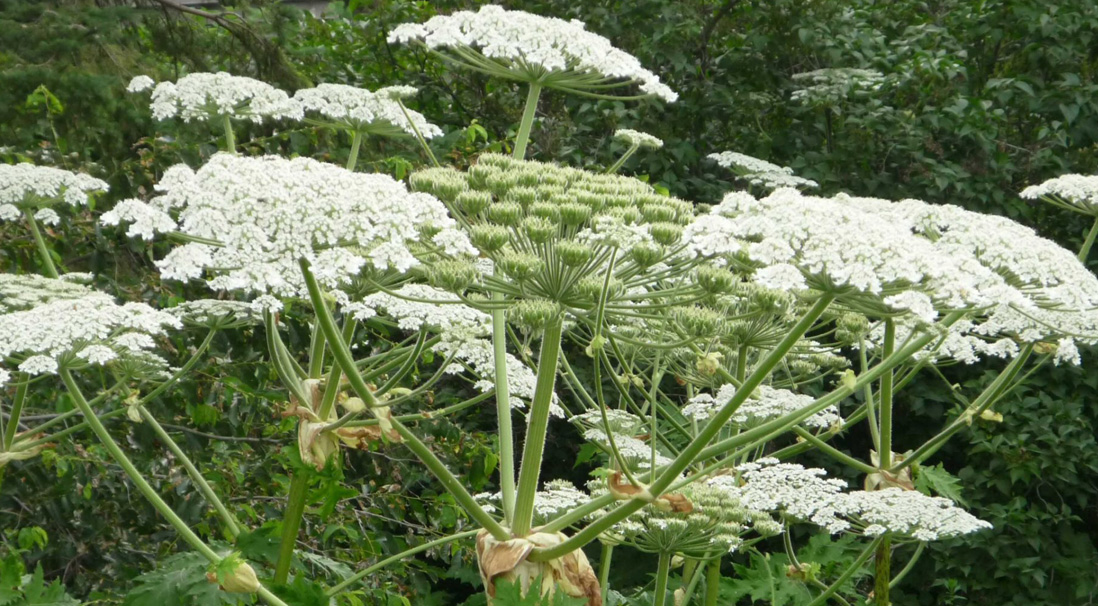 Giant hogweed (Heracleum mantegazzianum) is an invasive biennial or perennial plant species which is native to the Caucasus Mountains at the border of Europe and Asia. It was introduced to Ireland in the 19th Century as an ornamental garden plant. Since then, it has escaped into the wild and is scattered throughout the country. Giant hogweed grows best in rich, moist soil and is commonly found along streams, ditches, roadsides and wet meadows.
Giant hogweed (Heracleum mantegazzianum) is an invasive biennial or perennial plant species which is native to the Caucasus Mountains at the border of Europe and Asia. It was introduced to Ireland in the 19th Century as an ornamental garden plant. Since then, it has escaped into the wild and is scattered throughout the country. Giant hogweed grows best in rich, moist soil and is commonly found along streams, ditches, roadsides and wet meadows.
Why should we be worried about it?
Giant hogweed is considered to be a significant danger to public health. The stems, edges and undersides of the leaves are coated with fine hairs containing phototoxic sap. The slightest contact with human skin can cause severe dermatitis in the presence of sunlight. Effects may include welts, rashes, and blistering. The sap can also cause temporary or permanent blindness following contact with eyes. If skin comes into contact with Giant hogweed the affected area should be covered immediately from sunlight. The skin should then be washed with cold water and medical advice should be sought as soon as possible. Giant hogweed can invade farm and forestry land, reducing available agricultural area and biodiversity. Animals grazing Giant hogweed may be susceptible to poisoning or digestive disorders. Ingestion of Giant hogweed has been found to interfere with the fertility of female livestock.
How do we recognise Giant hogweed?
Giant hogweed looks like very large Cow parsley. It is distinctive due to its size and often grows 3-5 metres tall. The stems are hollow, ridged and green with a fine hair-like appearance. The stems range from 5-10cm in diameter. Its leaves can grow up to 1.5 metres long. The leaf edges are very coarse and serrated, like a jagged saw edge . Giant hogweed begins to grow in early spring and flowers between June and September. The flowers are white or rarely pink and are arranged in a large umbrella shape. Flower heads grow up to 0.5 metres in diameter. Seeds are released from late August to October. The dead stems remains standing during the winter and are topped with huge brown flower heads.
How does Giant hogweed spread?
Giant hogweed produces 20,000 to 50,000 seeds per plant. These are coin sized and paper thin. Some can be spread by the surface run-off of rain or in the wind. A small number of seeds can even be transported unintentionally by humans or livestock if trampled upon. Giant hogweed seeds can remain viable in the soil for up to 15 years.
How to manage Giant hogweed
Giant hogweed is an invasive species which is extremely difficult to eliminate from a site. The control of Giant hogweed should aim to eradicate the plant entirely or at a minimum, prevent the plant from producing seed. A number of physical or chemical controls may be employed to exhaust the plant’s seed bank. Please note that as the seeds remain viable for several years, control will require continued input and follow-up over a number of years. The best time to remove the plant is in late April or early May because the plant is usually less than 30cm tall, easier to dig up, and more susceptible to herbicides. Due to the serious health risks associated with Giant hogweed, it is recommended that all methods of control are carried out by trained and experienced personnel.
